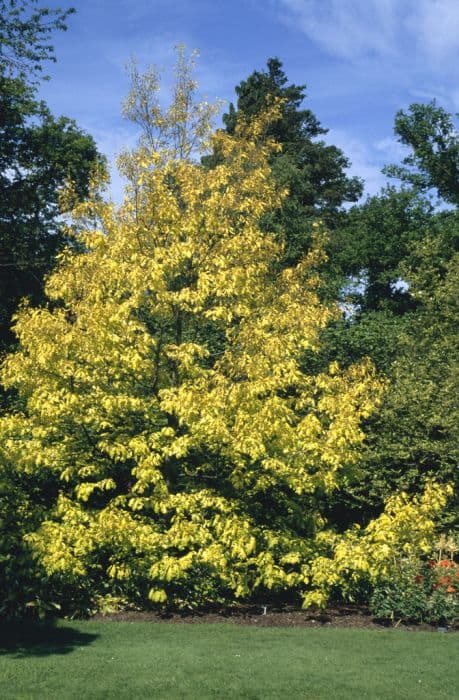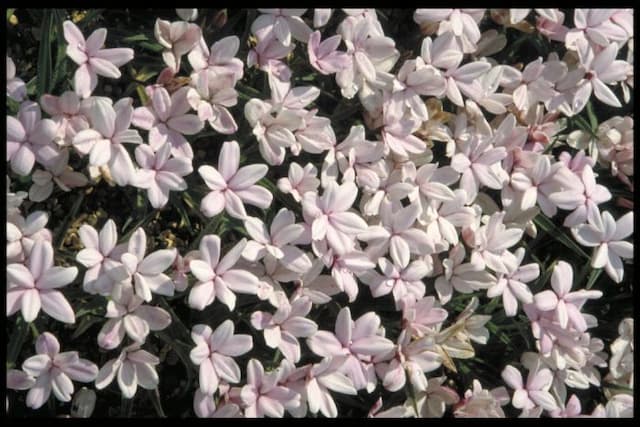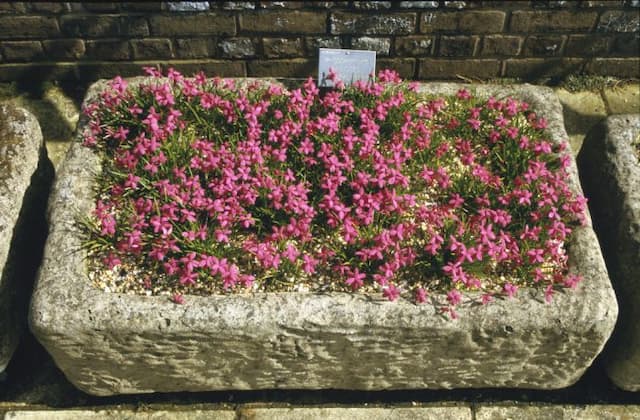Rhodohypoxis Rhodohypoxis 'Kiwi Joy' (d)

ABOUT
Kiwi Joy is a charming perennial with grass-like foliage and a clumping habit. Its leaves are narrow and strap-shaped, creating a dense tufted effect. This plant is particularly noted for its delightful flowers. The blossoms are star-shaped and come in a vibrant pink hue, with a deeper pink or sometimes red center which adds to their attractiveness. The petals have a soft, satiny appearance and radiate around a central point, giving them a symmetrical look. Kiwi Joy blooms over a long period, often from spring to early summer, adding a splash of color to garden spaces. Despite its delicate appearance, the plant is quite hardy and can endure a variety of conditions, though it thrives best in well-drained soil and with ample sunlight.
About this plant
 Names
NamesFamily
Hypoxidaceae.
Synonyms
Red Star, Rosy Posy, Rhodohypoxis Baurii.
Common names
Rhodohypoxis 'Kiwi Joy'
 Toxicity
ToxicityTo humans
There is no widely recognized evidence or reports suggesting that Rhodohypoxis baurii, commonly referred to as Rhodohypoxis, is toxic to humans. Generally, it is not regarded as a poisonous plant, and there are no well-documented symptoms of poisoning from ingesting parts of this plant. Nevertheless, since it is not meant for consumption, ingesting any plant matter may potentially cause gastrointestinal discomfort or an allergic reaction in sensitive individuals. As with any plant, it is prudent to avoid ingesting it if you are not certain of its edibility or potential effects on health.
To pets
Rhodohypoxis baurii, which is referred to simply as Rhodohypoxis, is not known to be toxic to pets such as cats and dogs. There is a lack of information indicating that this plant would cause harm if ingested by animals. As a precaution with non-food plants, pet owners should always monitor their pets around plants, as individual animals may have different sensitivities, and ingestion of non-food items can potentially lead to gastrointestinal upset or other issues due to the physical properties of plant matter rather than its chemical toxicity.
 Characteristics
CharacteristicsLife cycle
Perennials
Foliage type
Deciduous
Color of leaves
Green
Flower color
Pink
Height
0.5 feet (15 cm)
Spread
0.5 feet (15 cm)
Plant type
Bulb
Hardiness zones
5
Native area
South Africa
Benefits
 General Benefits
General Benefits- Aesthetic Appeal: Adds a charming splash of color to gardens with its bright pink or red flowers.
- Low Maintenance: An easy-to-care-for perennial that requires minimal upkeep once established.
- Compact Size: Ideal for rock gardens, alpine beds, or small spaces due to its small stature.
- Attracts Pollinators: Encourages biodiversity by attracting bees and other pollinating insects.
- Drought Tolerance: Once established, it can tolerate periods of dryness, making it suitable for water-wise gardens.
- Seasonal Interest: Provides seasonal interest in late spring to early summer when in bloom.
- Ground Cover: Dense growth habit can help suppress weeds and cover bare spots in the landscape.
- Cold Hardy: Capable of withstanding cooler temperatures, making it suitable for various climates.
 Medical Properties
Medical PropertiesThis plant is not used for medical purposes.
 Air-purifying Qualities
Air-purifying QualitiesThis plant is not specifically known for air purifying qualities.
 Other Uses
Other Uses- Rhodohypoxis 'Kiwi Joy' can serve as a vibrant addition to fairy gardens due to their small size and colorful blossoms, enhancing the miniature landscape.
- This plant's compact nature allows it to be used in trough gardens, where space is limited and detailed, small-scale plantings are desired.
- The colorful blooms of Rhodohypoxis 'Kiwi Joy' can be a natural food dye for culinary purposes, offering a sustainable and chemical-free way of coloring foods.
- As an educational tool in botany classes, it showcases bulbous plant growth and the impact of seasonal changes on perennial plants.
- These plants can be used in photography as a subject for macro photography, allowing photographers to capture the intricacies of tiny flowers.
- The vibrant petals of Rhodohypoxis 'Kiwi Joy' can be used to create botanical prints on fabric or paper, utilizing the natural pigment for artistic impression.
- It can be incorporated into living wreaths or floral decorations for festive occasions, providing a unique and fresh touch.
- Can be used as a natural indicator plant to signal the beginning of summer as it flowers during late spring to early summer.
- They can be used as a ground cover beneath solar panels in a garden to improve aesthetics while allowing easy access for maintenance.
- These plants could be used in stop-motion animation as a representation of flora due to their small size and colorful appearance.
Interesting Facts
 Feng Shui
Feng ShuiThe Rhodohypoxis baurii is not used in Feng Shui practice.
 Zodiac Sign Compitability
Zodiac Sign CompitabilityThe Rhodohypoxis baurii is not used in astrology practice.
 Plant Symbolism
Plant Symbolism- Joy and Happiness: As suggested by the name 'Kiwi Joy', this plant is often associated with cheerfulness and the lifting of spirits, symbolizing good moods and positivity.
- Resilience and Hardiness: Rhodohypoxis are known for their ability to thrive in alpine environments, which implies durability and the ability to endure challenging conditions.
- New Beginnings: The blooming of flowers, particularly in spring, is frequently symbolic of new starts and the awakening of life after a dormant period.
- Innocence and Purity: The delicate appearance of the blossoms can convey a sense of purity and simplicity, often representing innocence.
 Water
WaterRed star plants like Rhodohypoxis 'Kiwi Joy' should be watered regularly during their growing season in spring and summer every few days, ensuring the topsoil slightly dries out between waterings. Use about one to two ounces of water for smaller pots or up to half a gallon for larger pots each time you water. Reduce watering in the fall and allow the soil to dry out more considerably, as the plant enters dormancy in winter.
 Light
LightRed star plants prefer bright, indirect light and should be placed in locations where they receive this light condition for the majority of the day. Direct sunlight can be tolerated, but it is important to avoid the harsh afternoon sun that can scorch the leaves. Morning light or filtered sunlight through a sheer curtain would be ideal for this plant.
 Temperature
TemperatureThe red star plant thrives in temperature ranges from 60°F to 75°F. It can tolerate minimum temperatures down to about 40°F but should not be exposed to frost. Ideal conditions include a consistent temperature within that range avoiding drastic fluctuations for optimal growth.
 Pruning
PruningPruning of red star plants is not usually necessary, as they are low-growing and maintain a compact form. Remove dead or fading flowers to encourage new growth. The best time for any necessary pruning is after the blooming period in late summer.
 Cleaning
CleaningAs needed
 Soil
SoilBumblebee plant prefers well-draining soil with a slightly acidic to neutral pH around 5.5 to 7.0. A mix of 2 parts peat, 1 part perlite, and 1 part fine sand works well to ensure proper drainage and aeration.
 Repotting
RepottingBumblebee plants typically need repotting every 2-3 years. It's best to repot them in spring before new growth begins.
 Humidity & Misting
Humidity & MistingBumblebee plant thrives in moderate humidity levels but is versatile and can adapt to average home humidity conditions.
 Suitable locations
Suitable locationsIndoor
Place in bright, indirect light and moderate humidity.
Outdoor
Plant in partial shade with shelter from harsh sun.
Hardiness zone
5-9 USDA
 Life cycle
Life cycleRhodohypoxis 'Kiwi Joy', commonly known as Rhodo Hypoxis, begins its life as a small, bulb-like corm that goes dormant in winter. In spring, the corm sends up fresh green foliage and begins the vegetative stage, producing narrow, grass-like leaves. Following the leaf-growth phase, it enters the flowering stage in late spring to summer, showcasing vibrant pink to red star-shaped flowers. After pollination, typically by insects, the plant may produce small seed capsules, marking its reproductive stage. Seeds released from the capsules can germinate to produce new plants. As temperatures cool, the foliage dies back, and the plant re-enters dormancy, conserving energy in the corm for the next growing season.
 Propogation
PropogationPropogation time
Spring-Early Summer
Propogation: Rhodohypoxis 'Kiwi Joy', commonly referred to as Rhodohypoxis, is best propagated by dividing the bulbs during their dormancy period, which is typically in the late summer to autumn after the foliage has died back. The most popular method for Rhodohypoxis propagation is to gently separate the small corms or bulbs from the main plant. Care should be taken not to damage the delicate roots while separating them. Once separated, the corms can be planted in a well-draining soil mix at a depth of about 1 inch (approximately 2.5 centimeters) and spaced around 3 inches (about 7.5 centimeters) apart. Ensure that the new plantlets are kept in a location with good light but protected from intense midday sun and that the soil is kept slightly moist but not waterlogged. With proper care, these new plants will establish themselves and be ready for the next growing season.
![Rhodoxis [Fairytale]](/_next/image?url=https%3A%2F%2Fplants-admin.emdemapps.com%2Fimages%2Fplants%2F%2Fimages%2F604b54204420d.png&w=640&q=75)



